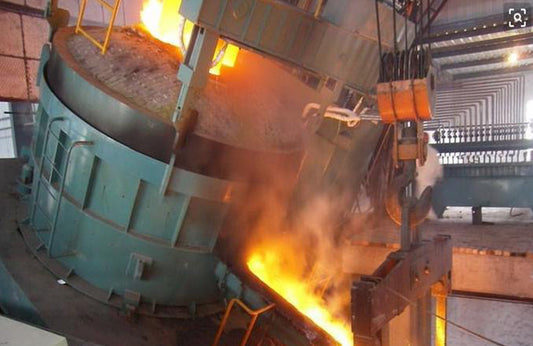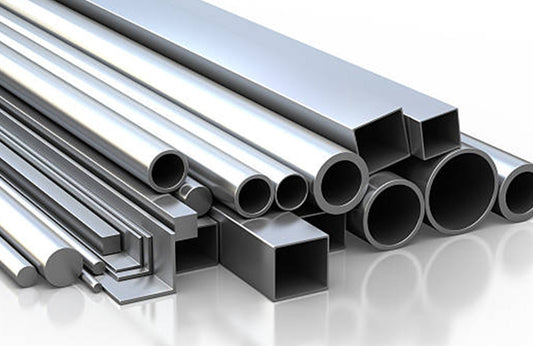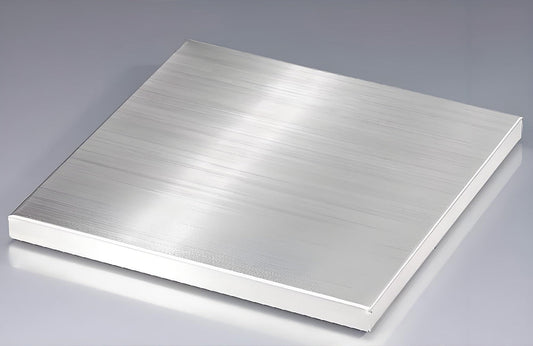
Stainless Steel Heat Treatment: Functions, Variations, and Applications
Stainless steel is widely used in construction, medical, mechanical, food, and other industries due to its excellent corrosion resistance and versatility. However, “rust resistance” is not an inherent property of stainless steel but rather the result of regulating its internal microstructure through heat treatment processes.
I. Heat Treatment: The Core Process for Regulating Stainless Steel Properties
Heat treatment is a series of process technologies that alter a material's internal microstructure (i.e., “structure”) by controlling its heating, holding, and cooling processes, thereby specifically enhancing or optimizing material properties. For stainless steel, the core objectives of heat treatment are:
1. Enhancing Corrosion Resistance: Blocking Corrosion Pathways Through Structural Homogenization
Stainless steel's corrosion resistance primarily relies on a dense surface passivation film composed mainly of chromium oxide (Cr₂O₃). However, if the internal microstructure is non-uniform (e.g., containing chromium-depleted zones), the passivation layer can be locally compromised, accelerating corrosion. Heat treatment enhances corrosion resistance through the following methods:
Solution treatment for austenitic stainless steel: Heating to 1000-1150°C allows alloying elements like carbon and nickel to fully dissolve into the austenite, forming a uniform solid solution. Rapid cooling (water quenching) prevents carbon from combining with chromium to form chromium carbide (Cr₂₃C₆), avoiding chromium depletion near grain boundaries (chromium-depleted zones) and thus preserving the integrity of the passivation film. For example, after solution treatment, the surface passivation film of 304 stainless steel food storage tanks becomes denser, enabling long-term resistance to corrosion from saltwater, fruit juices, etc.
Martensitic Stainless Steel Tempering: In quenched martensitic structures, carbon exists in a supersaturated state, readily forming carbides with chromium. Tempering (150-650°C) decomposes some carbides, redistributing chromium uniformly throughout the matrix and enhancing passivation film stability. For example, after tempering, the corrosion resistance of 4Cr13 surgical blades improves from susceptibility to rust at HRC 50 to long-term stability at HRC 60.
2. Adjusting Mechanical Properties: Controlling Hardness and Toughness Balance Through Phase Transformation
The mechanical properties of stainless steel (hardness, strength, toughness) are directly related to its internal microstructure (e.g., martensite, tempered sorbite). Heat treatment achieves “customization” through phase transformations:
Quenching of martensitic stainless steel: Heating to 950-1050°C (austenitizing temperature), followed by rapid water cooling “traps” carbon in martensite, forming a high-hardness martensitic structure (HRC 50-60). For example, 4Cr13 tool steel achieves HRC 60 hardness after quenching, meeting cutting requirements.
The “softening” effect of tempering: Quenched martensite exhibits high brittleness, necessitating tempering (150-650°C) to decompose part of the martensite into tempered sorbite (with dispersed carbides). This reduces brittleness while retaining strength. For instance, valve springs made from 4Cr13 steel require tempering at 300-400°C after quenching to reduce hardness to HRC45-50 while maintaining elasticity.
3. Improving Machinability: Eliminating Work Hardening and Restoring Plasticity
Cold working (e.g., cold rolling, stamping) generates numerous dislocations (atomic misalignments) within stainless steel, causing work hardening (30%-50% hardness increase, reduced plasticity). Heat treatment restores machinability through:
Stress-relief annealing: Post-cold-worked stainless steel (e.g., cold-rolled 304 sheet) is heated to 600-700°C and held to rearrange dislocations and eliminate internal stresses. Hardness is reduced to the required range for processing (e.g., from HV250 to HV180), restoring plasticity for subsequent stamping or bending.
4. Stabilizing dimensional accuracy: Reducing internal stresses to prevent deformation and cracking
During forming processes (e.g., welding, cold bending) or heat treatment, stainless steel develops residual stresses due to uneven temperature distribution, potentially causing deformation or cracking. Heat treatment stabilizes dimensions by homogenizing the temperature field and releasing stresses:
Stress-Relief Annealing: After manufacturing large stainless steel structural components (e.g., chemical storage tanks), heating to 500-600°C with holding allows residual stresses to gradually dissipate through atomic diffusion, preventing deformation caused by stress release during subsequent use.
II. Grade Differences: The “Genetic Foundation” of Stainless Steel Heat Treatment
Stainless steel “grades” (e.g., 304, 316, 430) are defined by their chemical composition (particularly chromium, nickel, and carbon content), which directly determines their room-temperature microstructure (e.g., austenite, martensite, ferrite). Different microstructures exhibit distinct atomic arrangements, resulting in fundamental differences in heat treatment objectives and process pathways (see Table 1).
| Category | Typical Grade (UNS) | Basic Microstructure | Key Characteristics | Common Applications |
| Austenitic | 304 (S30400) | Austenite | Excellent corrosion resistance, non-magnetic, good formability | Food processing equipment, architectural decoration, chemical containers |
| Austenitic | 316 (S31600) | Austenite | Superior pitting resistance (due to Molybdenum content) | Coastal facilities, medical instruments, marine engineering |
| Martensitic | 420 (S42000) | Martensite | High hardness and strength, moderate corrosion resistance | Cutlery, bearings, mechanical parts |
| Martensitic (PH) | 17-4PH (S17400) | Martensite + Precipitation Hardening | High strength combined with good corrosion resistance | Aerospace fasteners, precision machinery parts |
| Ferritic | 430 (S43000) | Ferrite | Good corrosion resistance, resistant to high-temperature oxidation | Architectural trim, appliance housings |
III. Form Variations: Heat Treatment Challenges Across Products
The product form of stainless steel (plate, tube, coil, bar) directly impacts uniformity control during heat treatment—more complex shapes pose greater challenges in achieving consistent internal/external temperatures and cooling rates, necessitating tailored process parameter adjustments (see Table 2).
| Form | Common Size Range | Heat Treatment Challenges | Process Adjustment Guidelines |
| Plate/Sheet | Thickness: 0.5-3mm (Thin), 3-20mm (Medium), 20-100mm (Thick) | Risk of warping; significant temperature gradient between surface and core in thick plates. | Use continuous annealing lines (seconds-level heating) for thin sheets. Use box furnaces for thick plates with extended soaking time and controlled slow cooling to prevent warping. |
| Tube/Pipe | Diameter: Φ20-200mm (Small), Φ200-500mm (Large); Wall Thickness: 1-20mm | Uneven cooling between the inner and outer walls due to hollow structure. | Use induction heating for small-diameter, thin-wall tubes (temp. difference ≤50°C). Use pit furnaces for large-diameter, thick-wall pipes, followed by oil or forced air cooling. |
| Coil/Strip | Width: 1-2m; Thickness: 0.3-3mm (Thin), 3-10mm (Thick) | Interlayer sticking (annealing sticker marks); significant residual stress. | Use bell annealing furnaces with protective atmosphere (N₂ + H₂). Employ step-cooling (5-10°C/min down to 400°C). |
| Bar/Rod | Diameter: Φ10-100mm (Small), Φ100-200mm (Large) | Difficulty in heating the core uniformly; high risk of cracking during quenching. | Use box furnaces with rapid heating and short water quenching (≤1 min) for small diameters. Use salt bath furnaces for large diameters with martempering (quenching into 200-300°C salt bath). |
IV. Application Differences: Demand-Driven Process Customization (Including Grade and Dimension Recommendations)
The final application scenario of stainless steel directly defines its required core properties (e.g., corrosion resistance, strength, toughness). Heat treatment processes must be tailored to these demands, optimizing parameters based on specific grades and dimensions.
1. Architectural Decoration: Prioritizing Aesthetics and Durability
Core Requirements: Scratch-free surface, uniform color, rust resistance under long-term atmospheric exposure, dimensional stability (deformation ≤0.5mm).
Recommended Grades and Dimensions:
- Interior Decoration: 304 stainless steel (0.5-3mm plates, φ20-150mm tubes), corrosion resistance suitable for everyday environments;
Coastal/High-Humidity Environments: 316 stainless steel (1-3mm thick plates, φ50-200mm diameter tubes), containing molybdenum (Mo) for enhanced pitting resistance;
Decorative Tubing: 201 stainless steel (0.8-2mm thick sheets, φ20-100mm diameter tubes), low cost with easy surface polishing.
Process Selection: Bright annealing (protective gas + slow cooling).
Example: 304 stainless steel curtain wall panels (1mm thick) exhibit no blue-yellow oxide discoloration after bright annealing, with salt spray corrosion resistance ≥500 hours; 316 decorative tubes (φ100mm diameter) show no intergranular corrosion risk at welds post-annealing.
2. Mechanical Manufacturing Sector: Prioritizing Strength and Precision
Core Requirements: Components (e.g., bearings, valves) must withstand high loads (≥500MPa), maintain dimensional accuracy (deformation ≤0.1mm), and exhibit fatigue resistance.
Recommended Grades and Dimensions:
High-Hardness Bearings: 440C stainless steel (φ20-100mm bar stock), hardness HRC60-62;
Elastic components: 17-4PH stainless steel (φ10-50mm bar stock), strength HRC40-50;
Valves/piping: 304 stainless steel (φ50-500mm tubing), balanced corrosion resistance + strength.
Process selection: Quenching + low-temperature tempering (precisely controlled cooling rate).
Example: 440C bearing race (φ50mm diameter) quenched to HRC62, post-tempering deformation ≤0.05mm at 150°C, with 30% increased service life; 17-4PH gear (module 2) treated via “solution annealing + aging,” achieving HRC45 tooth surface hardness with fatigue resistance superior to standard steel.
3. Food & Medical Fields: Hygiene and Safety as the Bottom Line
Core Requirements: No toxic element leaching, easy-to-clean surfaces (roughness Ra ≤ 0.8μm), acid/alkali resistance (e.g., withstands 10% hydrochloric acid, 20% sulfuric acid).
Recommended Grades & Dimensions:
Surgical Instruments: 420 stainless steel (100-200mm bar stock), high hardness HRC55-60;
Food machinery: 304 stainless steel (φ10-200mm tubing, 0.8-3mm plate), non-magnetic and resistant to juice corrosion;
Medical containers: 316L stainless steel (50-500L capacity, 1-2mm plate), ultra-low carbon (C ≤ 0.03%) to prevent intergranular corrosion.
Process Selection: Solution treatment + polishing (combining heat treatment with surface finishing).
Example: 420 surgical blade (150mm length) undergoes solution treatment (1050°C) + tempering (200°C), achieving HRC60 hardness and surface roughness Ra≤0.6μm, meeting surgical cutting requirements; A 316L food mixer inner tank (φ300mm diameter) achieved ≥1000 hours of citric acid corrosion resistance after solution treatment.
V. Other Critical Factors: Impact of Production Batch Size and Original Condition
Beyond the above dimensions, stainless steel heat treatment is also influenced by production batch size and original condition (hot-rolled/cold-rolled), requiring flexible process adjustments to balance cost and quality.
Production Batch Size:
Small batches (≤100 pieces): e.g., customized decorative tubes. Employ box furnaces with flexible temperature adjustment (±10°C deviation), allowing single-batch process optimization.
Large batches (≥1000 pieces): e.g., automotive stainless steel exhaust pipes (diameter φ80-150mm). Utilize automated continuous annealing lines (temperature deviation ±5°C) to ensure batch consistency.
Original Condition:
Hot-rolled materials (e.g., hot-rolled 304 steel plate, thickness 5-20mm): Coarse microstructure requires recrystallization annealing (700-800°C, 2-hour soak) to refine grains and relieve casting stresses;
Cold-rolled material (e.g., cold-rolled 430 decorative sheet, thickness 0.5-1mm): Cold work hardening (hardness HV200-250) requires stress relief annealing (600-700°C for 1 hour) to restore ductility for stamping forming.
VI. Frequently Asked Questions
Q1: What are the differences in heat treatment processes between 304 and 316 stainless steel?
A: Both are austenitic stainless steels, but 316 contains molybdenum (Mo), requiring a higher solution treatment temperature (1050-1100°C) to ensure complete Mo dissolution. Excessively high solution treatment temperatures (>1150°C) for 304 may cause grain coarsening and reduce corrosion resistance. Rapid water quenching is essential for both grades to prevent chromium carbide precipitation.
Q2: Must martensitic stainless steel be tempered after quenching?
A: Tempering is essential. Quenched martensite exhibits high hardness but extreme brittleness (e.g., 420 steel reaches HRC 60 after quenching, with brittleness causing susceptibility to fracture). Tempering (150-650°C) decomposes some carbides, reducing brittleness while retaining strength (e.g., 420 steel tempered at 300°C achieves HRC 55 with 50% improved toughness).
Q3: What are the differences in heat treatment processes for small-diameter and large-diameter stainless steel pipes?
A: Small-diameter thin-walled pipes (φ ≤ 50mm, wall thickness ≤ 3mm) use induction heating (rapid heating to quenching temperature) + water spray cooling (internal/external temperature difference ≤ 50°C); Large-diameter thick-walled tubes (φ≥150mm, wall thickness ≥10mm) use pit furnace uniform heating (holding time extended to 1.5-2 hours) + oil quenching + air cooling (to prevent internal wall cracking from rapid cooling).
Q4: Do food-grade stainless steels (e.g., 304, 316L) require additional testing after heat treatment?
A: Yes. Testing is required for passivation film integrity (e.g., electrochemical corrosion testing), harmful element leaching (e.g., lead, cadmium), and surface roughness (Ra ≤ 0.8μm) to ensure compliance with food contact material safety standards (e.g., GB 4806.9-2016).
Conclusion
Stainless steel heat treatment is a systematic engineering process integrating materials science and process control. From enhancing corrosion resistance through microstructural homogenization to adjusting mechanical properties via phase transformation control; from addressing uniformity challenges across diverse forms to tailoring processes for specific application requirements—each step demands precise alignment with material characteristics and target performance. Understanding these variations (including grade, form, dimensions, and application) not only helps enterprises optimize production and reduce costs but also delivers more durable, safer stainless steel products to users—embodying the core value of stainless steel heat treatment.



